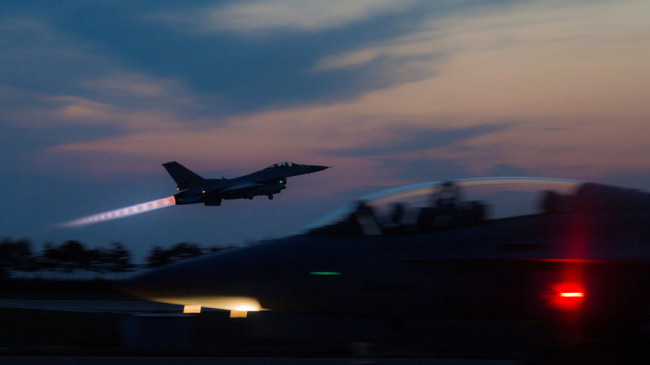Despite North Korea’s decision to postpone high-level talks with South Korea in protest against a combined air drill with the US, the ongoing Max Thunder exercise will proceed as scheduled, the Defense Ministry said Wednesday.
About 100 aircraft from the allies’ air forces, including eight F-22 stealth fighter jets, are participating in the exercise that kicked off Friday, according to military officials. The annual drill is scheduled to continue until May 26.
“The exercise will proceed as planned, and regarding that, there are no differences between the South and US,” the Defense Ministry said, dismissing possibilities that there may be a suspension of the drills or a reduction in its scope.
The remarks came after Defense Minister Song Young-moo and Gen. Vincent Brooks, the commander of US Forces Korea, held an emergency meeting to discuss Pyongyang’s abrupt decision to postpone high-level inter-Korean talks slated for Wednesday.
During the closed-door meeting, Song asked Brooks not to deploy nuclear-capable B-52 Stratofortress bombers for the Max Thunder exercise, presidential special adviser Moon Chung-in said during a meeting with lawmakers Wednesday.

A South Korean Air Force F-16 Fighting Falcon aircraft takes off during exercise Max Thunder. (Reuters)
In announcing the postponement, North Korea’s state-run Central News Agency denounced South Korea for undermining the spirit of an inter-Korean detente by working with the US to engage in a massive war rehearsal.
Given that Pyongyang made no criticism when the military exercise kicked off and Kim Jong-un reportedly said he would “understand” US-South Korea drills, analysts suspected there could be more significant reasons behind Pyongyang’s sudden change of mind.
“In terms of timing, North Korea’s behavior doesn’t quite add up. I think there is more behind the decision,” Kim Dae-yong, a military analyst at the Korea Research Institute for National Strategy in Seoul, said.
There were no criticisms from North Korea on May 11 when South Korea and the US kicked off Max Thunder, which Pyeongyang now describes as a military provocation designed for a pre-emptive airstrike on its territory.
Instead, the reclusive regime announced the following day its detailed plans to shut down the Punggye-ri nuclear test site, where North Korea conducted all of its six nuclear tests, including the most powerful one last year.
The United States had reportedly determined the scope of the exercise, including the deployment of the F-22, well before Trump accepted Kim Jong-un’s invitation for a summit in March.
“The scope of the exercise was determined at least months in advance,” a South Korean Air Force official told The Korea Herald under the condition of anonymity. “The decision was made definitely before the announcement of US-North Korea summit.”
Hosted by Air Force Operations Command and the US 7th Air Force, the Max Thunder exercise is designed to fend off North Korea’s air threats by conducing air-to-air combat drills under hypothetical scenarios.
Faced with North Korea’s nuclear and missile tests in 2016 and 2017, the allies’ militaries decided to incorporate the previous two Max Thunder exercises into parts of the massive field-training exercise Foal Eagle.
But the air drill was separated from Foal Eagle this year, as cross-border tension eased amid the mood for an inter-Korean detente following North Korea’s participation in the PyeongChang Winter Olympics in February
“I think there can be flexibility when it comes to the decision of whether to include Max Thunder into the Foal Eagle exercise,” Defense Ministry Spokesperson Choi Hyun-Soo said in March after the ministry announced the Max Thunder exercise plan.
By Yeo Jun-suk (jaonsyeo@heraldcorp.com)






![[Graphic News] More Koreans say they plan long-distance trips this year](http://res.heraldm.com/phpwas/restmb_idxmake.php?idx=645&simg=/content/image/2024/04/17/20240417050828_0.gif&u=)